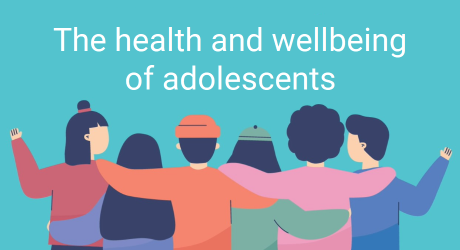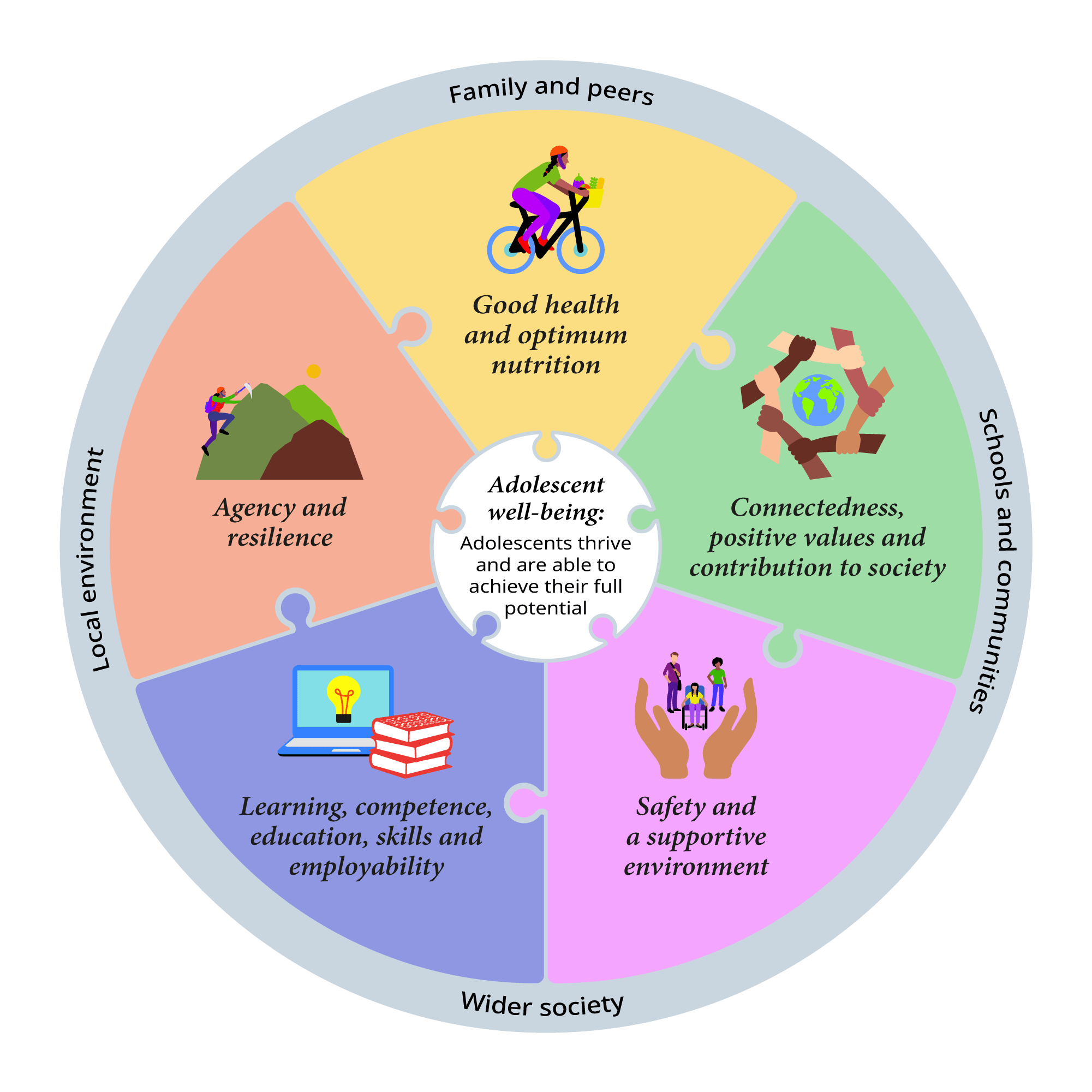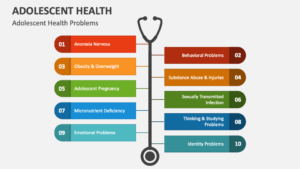
Table of Contents
What is Adolescent Health?
- Adolescence is the period of life between childhood and adulthood, lasting from the ages of 10 to 19 years.
- The physical, mental, and social well-being of adolescents is referred to as adolescent health.
- Young people go through major physical and emotional changes at this critical developmental stage, which can have a long-term effect on their health and well-being.
- A wide number of topics are included under the umbrella of adolescent health, such as sexual and reproductive health, mental health, substance abuse, nutrition, physical activity, and injury prevention.
- Additionally, it covers areas like Sexually Transmitted Infections (STIs) and contraception that are connected to sexual health.
- According to the Adolescent Wellbeing Framework developed by WHO and the Partnership for Maternal, Newborn & Child Health (PMNCH), in collaboration with the United Nations H6+ Technical Working Group on Adolescent Health and Well-Being, adolescent wellbeing is defined as “Adolescents have the support, confidence, and resources to thrive in contexts of secure and healthy relationships, realizing their full potential and rights” and covers five interrelated domains.”

Adolescent Health Facts
- In 2020, the number of deaths among adolescents and young adults aged 10-24 years was over 1.5 million, averaging almost 5,000 deaths per day.
- Among age groups, young adolescents aged 10-14 years face the lowest risk of death.
- The primary causes of death among adolescents and young adults are injuries, including road traffic accidents and drowning, violence, self-harm, and maternal conditions.
- Mental health disorders are a significant concern, with half of all cases in adulthood starting before age 14, yet most remain unnoticed and untreated.
- Substance use at a young age increases the risk of developing dependence and other problems during adulthood, with younger people more vulnerable to the effects of substance abuse than older individuals.
- In 2020, there were 41 births per 1000 girls aged 15-19 years worldwide.
Stages of Adolescence
Early adolescent (10-13 years)
- Early adolescence, spanning from 10 to 13 years of age, is marked by significant physical changes such as puberty, including hair growth, breast development, and testicular enlargement.
- Sexual curiosity and confusion also arise during this stage, as do monthly menstrual cycles for girls.
- This period is characterized by rapid cognitive development, with Jean Piaget calling it “concrete operational thinking.”
- Early adolescents have a black and white way of thinking, tend to be egocentric, and are self-conscious as they perceive criticism and judgment from others.
Middle adolescent (14-17 years)
- Middle adolescence occurs between ages 14-17 and is a time of significant physical change for boys, including voice change and growth spurts.
- Girls have generally finished physical development. This stage is marked by a growing desire for romantic relationships, but can be challenging for transgender and bisexual teens.
- Middle adolescents can also begin to think beyond their own preferences and appreciate others’ opinions.
Late adolescent (18-19 years)
- Late adolescence, typically between ages 18-21, marks the final stage before adulthood.
- Physical development is complete by this point, and individuals in this age group demonstrate improved impulse control and decision-making abilities.
- Relationships with others begin to stabilize and deepen, and late adolescents start making independent life choices that will impact their future.
- As they transition to adulthood, parents become more like role models rather than primary sources of guidance and permission.
Characteristics of Adolescents
1. Physical changes
- Adolescents experience significant changes in their physical appearance, including growth spurts, changes in body composition, and sexual maturation.
2. Developing identity
- Adolescents start to form their sense of identity and begin to understand who they are and what they want to do in life.
3. Emotional intensity
- Adolescents often experience intense emotions, which can range from excitement and happiness to anger and sadness.
4. Risk-taking behavior
- Adolescents are more likely to engage in risk-taking behaviors, such as drug use, unprotected sex, and reckless driving.
5. Peer influence
- Adolescents are heavily influenced by their peers and often seek out social acceptance and approval.
6. Brain development
- Adolescents’ brains are still developing, which can result in impulsive behavior, difficulty with decision-making, and a greater sensitivity to rewards and social cues.
7. Seeking independence
- Adolescents often seek greater independence from their parents and authority figures, as they strive to establish their own autonomy and identity.
- On to adulthood, parents become more like role models rather than primary sources of guidance and permission.
Factors Affecting Adolescence
1. Family dynamics
- The quality of family relationships and parenting styles can significantly impact adolescents’ emotional and social development.
2. Peer influence
- Adolescents often feel pressure to conform to their peer group, which can influence their behavior, attitudes, and beliefs.
3. Socioeconomic status
- Adolescents from low-income families may face additional challenges, including limited access to resources and opportunities.
4. Culture and ethnicity
- Adolescents’ cultural and ethnic backgrounds can shape their experiences, beliefs, and attitudes, which can impact their social and emotional development.
5. Education
- The quality of education and access to educational opportunities can significantly affect adolescents’ academic and career prospects.
6. Health and well-being
- Adolescents’ physical and mental health can impact their overall development and well-being.
7. Technology and media
- The use of technology and media can impact adolescents’ cognitive development, social skills, and mental health.
Major Health Issues and Other Problems During Adolescence
- Injuries
- Violence
- Mental Health
- Alcohol and drug use
- Tobacco use
- HIV and other infectious diseases
- Early pregnancies and childbirth
- Nutrient and micro-nutrient deficiency
- Under nutrition and obesity

How Can We Prevent Adolescent Health Problems?
- Stronger road safety laws and enforcement lower blood alcohol levels for young drivers, and graduated licenses for novice drivers with zero-tolerance for drunk-driving are recommended.
- Prevention strategies include early childhood development, school-based bullying prevention, life and social skills programs, and community initiatives to limit access to alcohol and firearms.
- The physical and psychological effects of adolescent survivors of violence can be lessened with appropriate care, which includes ongoing support.
- Promoting socio-emotional skills and psychosocial support in children and adolescents can improve mental health.
- Prevention of alcohol and drug use requires population-based strategies and interventions, such as setting a minimum age for buying and consuming alcohol and eliminating marketing to minors.
- Access to HIV prevention interventions and comprehensive sexuality education are crucial for adolescents, and early HPV vaccination could save millions of lives.
- Quality antenatal care and safe abortion access are essential for pregnant adolescents.
- Creating safe environments and opportunities for physical activity and reducing the marketing of unhealthy foods can support healthy habits in adolescence.
Ways To Manage Adolescent Health Problems
- Promoting healthy behaviors
- Providing access to healthcare
- Offering mental health support
- Addressing sexual and reproductive health
- Preventing injuries
- Building social and emotional skills
- Engaging families and communities
References and For More Information
https://hqlo.biomedcentral.com/articles/10.1186/s12955-022-01954-6
https://www.healthychildren.org/English/ages-stages/teen/Pages/Stages-of-Adolescence.aspx
https://study.com/learn/lesson/stages-of-adolescence.html
https://www.who.int/health-topics/adolescent-health#tab=tab_1
https://www.paho.org/en/topics/adolescent-health
https://www.sciencedirect.com/topics/medicine-and-dentistry/adolescent-health
https://www.ncbi.nlm.nih.gov/books/NBK215418/
https://apps.who.int/iris/bitstream/handle/10665/255415/9?sequence=1